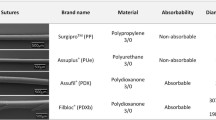Abstract
Background
Tissue damage during herniotomy may attribute to postoperative complications including chronic pain, bleeding and infection. Thus the aim of this study was to evaluate a due and simple operative procedure with intraperitoneal application of mesh with glue in an experimental model prior to use in humans.
Method
Laparoscopic insertion of a mesh was performed in three pigs. The meshes were fixed with a collagen glue. The pigs were sacrificed after 8 weeks and macroscopic and microscopic evaluation of the meshes, were performed.
Results
The intraperitoneal placed meshes did not migrate through the study period, and there was no sign of inflammation in surrounding tissue or adhesions around the meshes.
Conclusions
If these findings can be applied to human inguinal herniotomy, this may lead to significant fewer complications including development of acute and chronic pain, formation of seroma and infection. Furthermore the operation technique is very simple.



Similar content being viewed by others
References
M Bay-Nielsen FM Perkins HP Kehlet (2001) ArticleTitlePain and functional impairment 1 year after inguinal herniorrhaphy: a nation-wide questionnaire study Ann Surg 33 1–7 Occurrence Handle10.1097/00000658-200101000-00001
R Farouk PJ Drew A Qureshi et al. (1996) ArticleTitlePreliminary experience with butyl-2-cyanoacrylate adhesive in tension-free inguinal hernia repair Br J Surg 83 1100 Occurrence Handle1:STN:280:ByiD383psFc%3D Occurrence Handle8869313
KA LeBlanc WV Booth JM Whitaker DE Bellanger (2001) ArticleTitleLaparoscopic incisional and ventral herniorraphy: our initial 100 patients Hernia 5 41–45 Occurrence Handle10.1007/BF01576164 Occurrence Handle1:STN:280:DC%2BD3MzhsFGnsQ%3D%3D Occurrence Handle11387722
MSL Liem TJMV Vroonhoven Particlevan (1996) ArticleTitleLaparoscopic inguinal hernia repair Br J Surg 83 1197–1204 Occurrence Handle10.1046/j.1365-2168.1996.02496.x Occurrence Handle1:STN:280:ByiC3crkt1M%3D Occurrence Handle8983605
MS Liem EB Duyn Particlevan Y Graf Particlevan der TJMV Vroonhoven Particlevan (2003) ArticleTitleRecurrences after conventional anterior and laparoscopic inguinal hernia repair: a randomised comparison Ann Surg 237 136–141 Occurrence Handle12496541
K McCormack NW Scott PMNYH Go S Ross AM Grant (2004) Laparoscopic techniques versus open techniques for inguinal hernia repair (Cochran review) The Cochran Library, Issue 1 Wiley Chichester UK
MA Memon NJ Cooper B Memon I Memon KR Abrams (2003) ArticleTitleMeta-analysis of randomised trials comparing open and laparoscopic inguinal repair Br J Surg 90 1479–1492 Occurrence Handle1:STN:280:DC%2BD3srmsFOkug%3D%3D Occurrence Handle14648725
A Moreno-Egea R Liron E Girela JL Aguaryo (2001) ArticleTitleLaparoscopic repair of ventral and incisional hernias using a new composite mesh (parietex) Surg Laparosc Endosc Percutaneous Techn 11 103–106 Occurrence Handle10.1097/00019509-200104000-00007 Occurrence Handle1:STN:280:DC%2BD3MrgsV2msA%3D%3D
AS Poobalan J Bruce PM King WA Chambers ZH Krukowski CS Smith (2001) ArticleTitleChronic pain and quality of life following open inguinal hernia repair Br J Surg 88 1122–1126 Occurrence Handle10.1046/j.0007-1323.2001.01828.x Occurrence Handle1:STN:280:DC%2BD3MvktlWgtg%3D%3D Occurrence Handle11488800
J Schmidt MA Carbajo R Lampert H Zirngibl (2001) ArticleTitleLaparoscopic intraperitoneal only polytetrafluoroethylene mesh repair (IPOM) for inguinal hernia during spinal anaesthesia in patients with severe medical conditions Surg Laparosc Endosc Percutaneous Techn 11 34–37 Occurrence Handle10.1097/00019509-200102000-00008 Occurrence Handle1:STN:280:DC%2BD3M7mslCqtw%3D%3D
Acknowledgments
Institute of Experimental Clinical Science, Skejby University Hospital, is acknowledged for their assistance in performing the surgery. Sofradim® Trévoux, France, is acknowledged for economic support for the animal studies.
Author information
Authors and Affiliations
Corresponding author
Rights and permissions
About this article
Cite this article
Schulze, S., Kristiansen, V.B., Hansen, B.F. et al. Biological tissue adhesive for mesh-application in pigs: An experimental study. Surg Endosc 19, 342–344 (2005). https://doi.org/10.1007/s00464-004-9054-z
Received:
Accepted:
Published:
Issue Date:
DOI: https://doi.org/10.1007/s00464-004-9054-z




